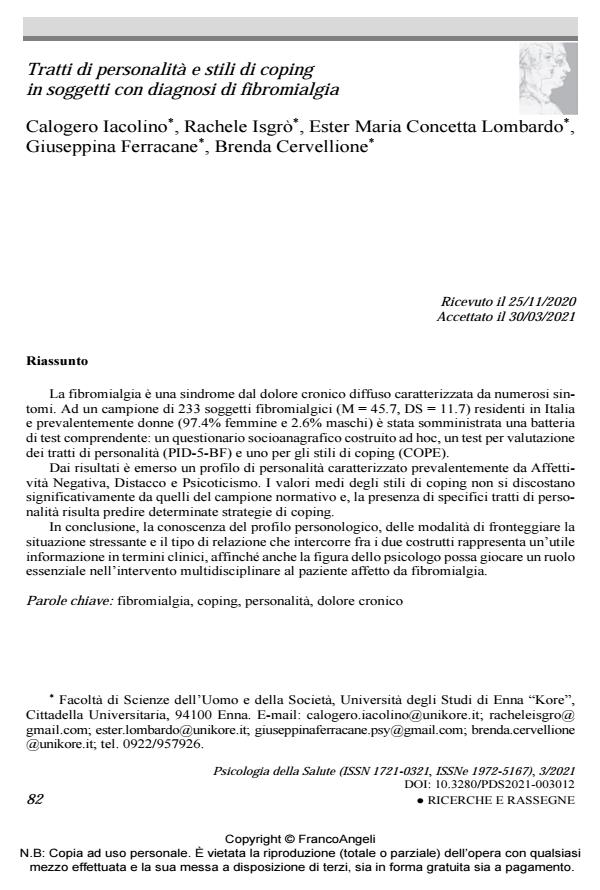Tratti di personalità e stili di coping in soggetti con diagnosi di fibromialgia
Titolo Rivista PSICOLOGIA DELLA SALUTE
Autori/Curatori Calogero Iacolino, Rachele Isgrò, Ester Maria Concetta Lombardo, Giuseppina Ferracane, Brenda Cervellione
Anno di pubblicazione 2021 Fascicolo 2021/3
Lingua Italiano Numero pagine 21 P. 82-102 Dimensione file 292 KB
DOI 10.3280/PDS2021-003012
Il DOI è il codice a barre della proprietà intellettuale: per saperne di più
clicca qui
Qui sotto puoi vedere in anteprima la prima pagina di questo articolo.
Se questo articolo ti interessa, lo puoi acquistare (e scaricare in formato pdf) seguendo le facili indicazioni per acquistare il download credit. Acquista Download Credits per scaricare questo Articolo in formato PDF

FrancoAngeli è membro della Publishers International Linking Association, Inc (PILA)associazione indipendente e non profit per facilitare (attraverso i servizi tecnologici implementati da CrossRef.org) l’accesso degli studiosi ai contenuti digitali nelle pubblicazioni professionali e scientifiche
La fibromialgia è una sindrome dal dolore cronico diffuso caratterizzata da numerosi sin-tomi. Ad un campione di 233 soggetti fibromialgici (M = 45.7, DS = 11.7) residenti in Italia e prevalentemente donne (97.4% femmine e 2.6% maschi) è stata somministrata una batteria di test comprendente: un questionario socioanagrafico costruito ad hoc, un test per valutazione dei tratti di personalità (PID-5-BF) e uno per gli stili di coping (COPE). Dai risultati è emerso un profilo di personalità caratterizzato prevalentemente da Affettività Negativa, Distacco e Psicoticismo. I valori medi degli stili di coping non si discostano signifi-cativamente da quelli del campione normativo e, la presenza di specifici tratti di personalità ri-sulta predire determinate strategie di coping. In conclusione, la conoscenza del profilo personologico, delle modalità di fronteggiare la situazione stressante e il tipo di relazione che intercorre fra i due costrutti rappresenta un’utile informazione in termini clinici, affinché anche la figura dello psicologo possa giocare un ruolo essenziale nell’intervento multidisciplinare al paziente affetto da fibromialgia.
Parole chiave:fibromialgia, coping, personalità, dolore cronico
Calogero Iacolino, Rachele Isgrò, Ester Maria Concetta Lombardo, Giuseppina Ferracane, Brenda Cervellione, Tratti di personalità e stili di coping in soggetti con diagnosi di fibromialgia in "PSICOLOGIA DELLA SALUTE" 3/2021, pp 82-102, DOI: 10.3280/PDS2021-003012